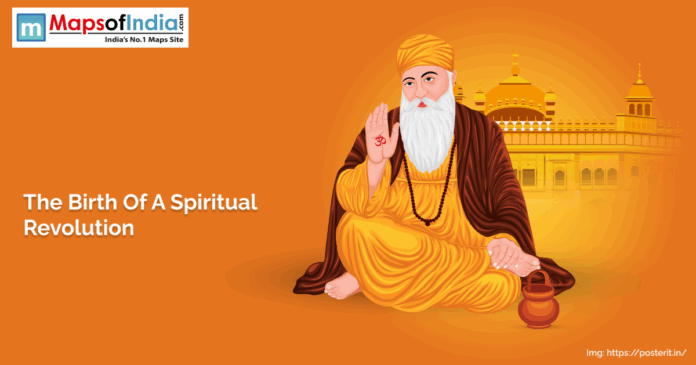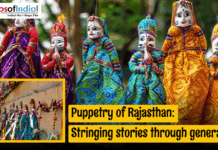Guru Nanak Jayanti is the most sacred celebration of sikh people, which is also known as Gurpurab. This day is celebrated to honour the birth of Guru Nanak Dev Ji. His message stressed fairness among people, sticking to honesty no matter what, while showing kindness without limits. This occasion also highlights how a single person’s drive for harmony sparked a powerful shift. The day is also about exploring the revolution that the one-man movement for unity and peace was.
The Birth of Guru Nanak Dev Ji
Guru Nanak Dev Ji came into the world in 1469. The village was known as Rai Bhoi di Talwandi in the old days. Today, this village is known as Nankana Sahib, located in present-day Pakistan. His arrival happened when society was split by strong tensions in religion, politics, and daily life. Around him, people faced unfair treatment, rigid class systems, along with habits followed without thought. From early childhood, he challenged problematic societal practices. Instead of walking the usual route others did, he leaned toward quiet thinking, showing kindness and insight that surprised those nearby.
A Time of Spiritual Awakening
Guru Nanak’s life was the start of a spiritual revolution. He did not accept that the differences of religion and caste should separate people. God is one, a trinity, called Ek Onkar, and all persons are equal in Him only. These he taught and preached. His teachings advocated love, service, and truth. This great gospel of love broke down barriers that separated people by birth and religion.
The Teachings that Transformed Society
He was conceptualised around, and his teachings were based on the reality that everything revolved around three things: Naam Japna, Kirat Karni and Vand Chakna. To begin with, Naam Japna is understanding God by meditation and performing good deeds. Kirat Karni is doing an honest job. And finally, Vand Chakna is the divine law of sharing what you have with others, in particular, the underprivileged. These doctrines became the cornerstones of the Sikh religion and are still leading human lives today.
Journey Across Lands
He didn’t just share what he knew with villagers. He carried his words across distant lands. This journey was part of something named Udasi, which led him through spots such as Tibet, Sri Lanka, Arabia, plus Persia. There, he chatted with folks from countless beliefs while also sitting down with holy figures, thinkers, and even everyday neighbours. His lessons aimed at sparking kindness between every kind of person out there. He didn’t only speak up – he followed through with action. Through what he did yet also how he spoke, he challenged old norms while offering folks something fresh to stand behind.
The Message of Equality
During the times when caste and gender were major issues that divided society, Guru Nanak was not hesitant to talk about equality. According to him, there was nothing in the world that men and women weren’t equal. He invited women to spirituality and social work. The good doctor of human rights was also a man of faith, he saw all human beings as reflections of the same divine light.
Rejecting Rituals and Superstition
Without hesitation, Guru Nanak criticized blind rituals and superstitions. He highly valued that the human outlook on spirituality should be turned inwards rather than outwards, and that those practices should be based on purity of heart and good manners. He was against those hollow rituals that were done to please the intangible by people who neglected truth and kindness. His focus was on the direct bond with God brought through true devotion and righteous living.
The Power of Hymns and Music
In Guru Nanak’s doctrines, singing played a vital part. To express his divine insight and love to man, he created wonderful lyrics called Shabads. Later, these compositions were compiled to form the Guru Granth Sahib, the Holy Book of the Sikhs. The man used the art of music as a connection hand, it was a very effective instrument to reach out to people’s hearts, irrespective of their religious or linguistic barriers. Nowadays, Kirtan, the rendition of these hymns, is the main Sikh worship form.
The Founding of Kartarpur Sahib
During his last years, Guru Nanak established the town of Kartarpur along the Ravi River. The place was notable for the egalitarian society that Guru Nanak developed there. The people from different walks of life worked, prayed, and ate together. This practice led to the invention of Langar, the free community kitchen which is available in every Gurdwara worldwide. Kartarpur turned into a utopia of his teachings-a place where no one was excluded.
Guru Nanak’s Philosophy of Work and Service
Guru Nanak put a lot of emphasis on the dignity of labor. In his view, honest work was a form of worship. He declared that no work was too small and that if one helped others, that was the highest form of devotion. The concept became a foundation of the Sikh community as one of self-reliance and community service.
The Spiritual Revolution That Lives On
The birth of Guru Nanak was more than the beginning of a new religion as the starting point of a spiritual revolution. He altered people’s perception of God, society, and their own selves. Although his revolt was non-violent, it was strong and effective. It broke down walls which had been imprisoning people for hundreds of years. Even now, the idea of oneness that he put forward is helping countless people to lead a balanced life of purpose.
Why His Message Still Matters
The world today and that of Guru Nanak’s time are quite similar in terms of the divisions they face. The message that he conveyed to his contemporaries is still valid today, as it tells us to go beyond religion, culture, or race when looking at people. According to him, serving the human race was the most exalted form of devotion. He acknowledges that there is the divine in everyone. He acted with compassion rather than being judgmental.
A Legacy of Light and Love
The message spread by Guru Nanak continues to be a source of light and an example for us. The celebration of his birth is a yearly event when people come together in joy and harmony. His teachings still exist through songs, prayers, and the kindness that is shared in every gurdwara. He did not resort to the use of weapons in his revolution, but rather to words of love, a heritage that is still helping people all over the world to open their hearts.




